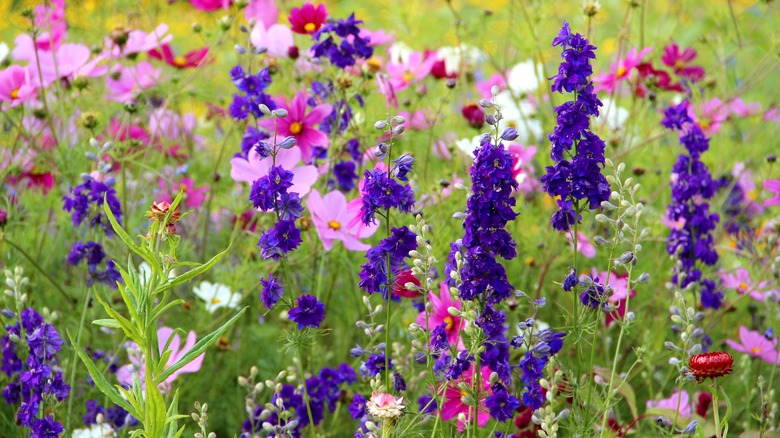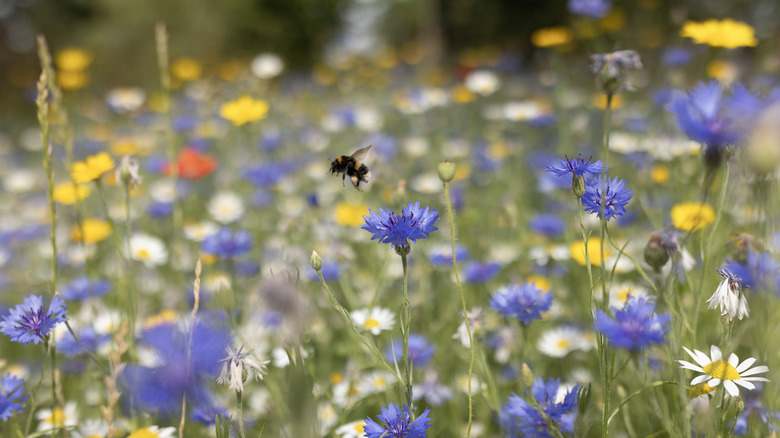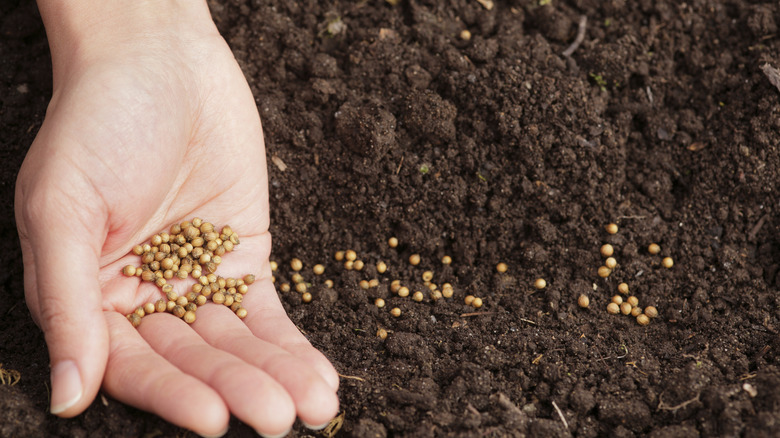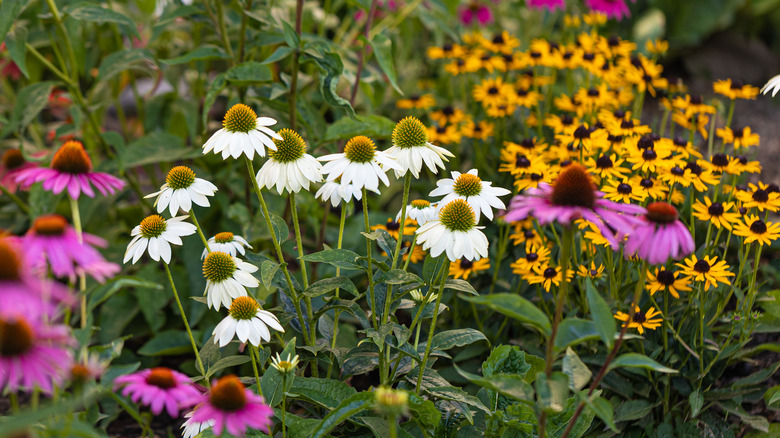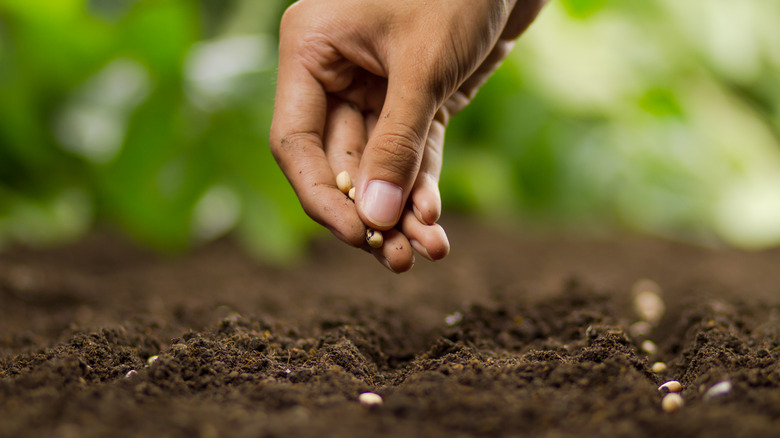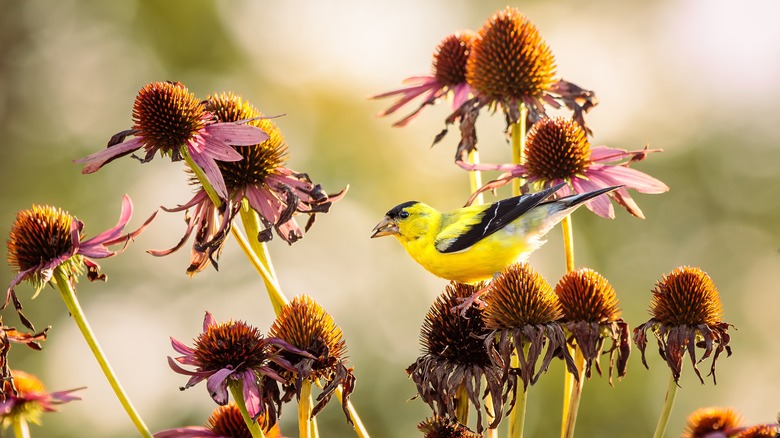The Best Time Of Year To Sow Wildflower Seeds
Wildflowers provide so many benefits in home gardens. They produce blooms from spring through autumn, and they attract beneficial pollinators such as honeybees, butterflies, dragonflies, and hummingbirds. Planting wildflowers from seed is very easy, and many wildflowers will reseed themselves naturally. Some wildflower seeds can be planted in either spring or fall. Autumn is the best default time to plant wildflower seeds, to help them get a good start, but some heat-loving flowers can be planted in spring.
Fall-planted wildflowers that will reseed themselves and come up in spring (like bachelor buttons, aka cornflowers) are usually very cold hardy and their seeds may need a period of cold stratification to germinate. They may flower that first spring, or they may flower the second year (this is common for coneflower, aka echinacea). Because most wildflowers grow from seed, they're considered annuals, though their tendency to reseed makes them seem like perennials. Some wildflowers are biennial (flowering every other year).
If this seems confusing, seed companies sell packages of mixed wildflower seeds made specifically for certain growing zones. This can give you the best mix of flowers that will thrive in your location. If you don't want to plant a mixture of seeds, you can also select the kinds of wildflowers you want to grow and purchase them separately. Just be sure to check planting instructions to know the best time and conditions for planting.
Cold hardy wildflowers
Many wildflowers are very cold hardy and have seeds that will germinate early in spring. They will easily produce new flowers even if the seeds lie on top of the soil all winter. These types of wildflower seeds usually need a period of cold stratification to germinate. They're basically annuals that behave like perennials — by reseeding themselves, there are always new flowers coming up each year.
Because cold hardy wildflowers have seeds that withstand cold temperatures, they tend to be strong and rather determined to grow, which means they can also become somewhat invasive in the garden. They're not invasive because they have tough root systems; they just seed themselves and produce many new plants. This is generally easy to control by just pulling up the young plants. Two exceptions are Black-eyed Susans (Rudbeckia hirta) and false sunflowers (Heliopsis helianthoides), which can both become quite invasive and difficult to get rid of. Check pre-packaged seed mixes for these and avoid them if you don't want to pull them out every year.
Common cold-hardy wildflowers that tend to reseed themselves easily include bachelor buttons (aka cornflowers), forget-me-nots, columbines, coreopsis, blanket flower (gaillardia), larkspur, California poppies, and blue flax flower. Once established, these varieties will generally reseed themselves reliably and give you plenty of flowers every year. Their seeds are also loved by birds and rodents, so letting them go to seed is good for wildlife, too.
Planting wildflower seeds in autumn
There are several good reasons to plant wildflower seeds in the autumn. One is that you may end up with fewer weeds, since wildflowers will start growing early in spring and fill in before weeds get the upper hand. Another is that you'll have spring and summer blooms happening earlier than if you plant seeds in spring. Autumn is also a good time to plant if you tend to have dry summers in your area, because winter precipitation will help provide moisture for seeds to germinate in spring.
Before planting wildflower seeds in autumn, wait until there have been a couple of hard frosts. This helps the seeds go into a dormant state to get the cold temperatures they require to help them germinate in spring. Plant on a day when there is no wind, to help keep them in place. Just sprinkle seeds on the soil surface after lightly raking the surface, then gently cover over with no more than a half inch of soil. Once soil temperatures reach 55 degrees Fahrenheit on a consistent basis, most fall-planted wildflower seeds will start to germinate.
Many wildflowers can be planted this way in autumn, including bachelor buttons (cornflowers), calendula, borage, California poppies, asters, coreopsis, lobelia, yarrow, blanket flower, Joe Pye weed, calendula, lupines, and butterfly weed. You can gather these seeds at the end of summer and save them to plant more in autumn or share them with your gardening friends.
Annual wildflowers suitable for warmer zones
If you live in a warmer growing zone, be sure to plant wildflower varieties that are suited to the conditions. Fortunately, there are many annual wildflowers that love warm weather and crave bright, hot sunny days. These flowers may even become perennial if your winters are mild enough. Try these varieties if you have plentiful sun and long hot summers.
Zinnias are native to Mexico, and their colors thrive in bright sunlight and hot temperatures. Both marigolds and their relations calendula (aka pot marigold) do well in heat and bloom for weeks. Black-eyed Susans bloom for weeks from midsummer through fall. They can be invasive, which is fine if you like them. Other Rudbeckias are less invasive and have interesting color variations on the golden yellow petals and black eyes, including petals of orange and even burgundy. Cleomes (aka spider flower) are heat-loving flowers that in lovely cool colors from white to pink to purple. Cosmos also thrive in heat, and their delicate petals come in both cool and warm colors.
If summer drought is a problem in your area, consider drought-tolerant wildflowers. These will continue blooming even without regular rainfall or watering. Coneflower (echinacea), California poppies, blue flax, scarlet flax, African daisy, penstemon, vervain, and Siberian wallflower can all tolerate dry conditions. If there is severe or prolonged drought, a small amount of water on the roots at sunset or in the very early morning can be beneficial.
Planting wildflower seeds in spring
Though not as common as fall planting, it's definitely possible to successfully grow wildflowers from seeds planted in the spring. When the last frost date has passed, it's safe to start sowing most wildflower seeds directly outside. This includes stock, statice, lupines, calendula, flax, Chinese forget-me-nots, snapdragons, and alyssum. For annuals that really like hot weather, like cosmos, sunflowers, and zinnias, wait until at least mid to late May. When the ground is warmed up, and daytime temperatures reach 70 degrees Fahrenheit, you can plant your heat-loving summer annual wildflower seeds.
If you want to and have the room to do so, you can also start your wildflower seeds indoors four to six weeks before the last frost date, then transplant them once it gets warmer outside. This will give you blooms a bit sooner. Wait until your seedlings are at least three inches high before transplanting, and check the weather forecast to make sure no extreme weather is expected that week.
Some gardeners may feel that starting wildflowers indoors goes against the whole concept of planting wildflowers, which are supposed to be "wild" after all. But once your wildflowers are established, you can collect seeds at the end of the season and have some to plant indoors, while others may reseed outdoors. Utilizing both indoor seed starting and direct outdoor seed planting methods in spring can help ensure a large, healthy number of wildflowers in your garden.
Let wildlife enjoy your wildflowers
If you don't want wildflower seeds to spread too much in your garden, you can deadhead or trim the stems before the flowers start releasing seeds in later summer or fall. Many gardeners collect their wildflower seeds at the end of the season and save them to replant, share, trade or even sell. Although collecting your seeds lets you save some money (by not having to buy new seeds), you can also just let the plants go dormant naturally without deadheading them. This is commonly referred to as letting them "go to seed."
This method usually has two likely results: first, the seeds will fall to the ground, and possibly be scattered slightly by wind or animal activity, and may regerminate in your garden the following spring. Second, the seeds will attract wildlife, mainly birds, who will eat the tasty seeds that are often full of nutrients. Birds may perch on the stems, or gather nearby to snack on the seeds. Or they may fly away with them, possibly dispersing them elsewhere.
Over time, you may try all of these methods before you decide what works best for you. You might find that you enjoy leaving some seeds for the birds and even for the pesky (but cute) squirrels. Letting your wildflowers go to seed helps to increase biodiversity in your garden, by attracting wildlife and encouraging a symbiotic relationship between the plants and animals.
